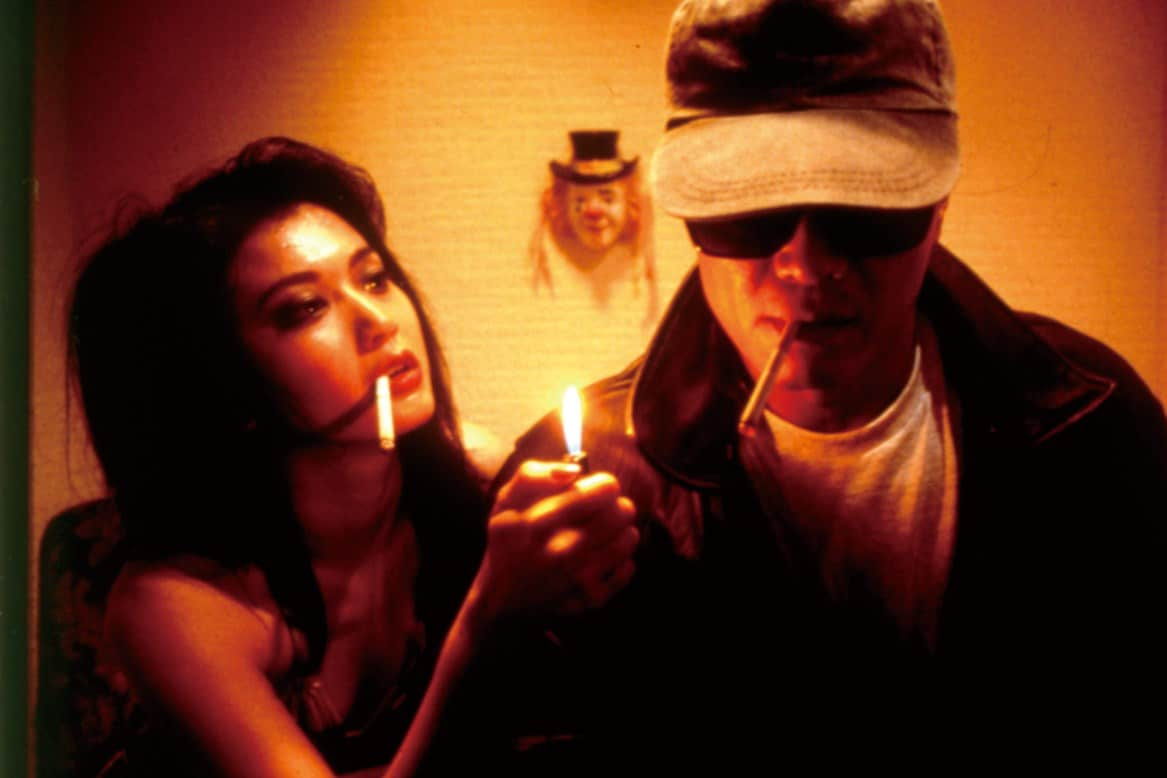A guide to the erotic, stylish cinema of Takashi Ishii14 Images
In the transitional decade that was the 80s, Japan’s once-dominant studio system faltered as even the most established directors struggled to secure funding for their projects. For aspiring creatives, the path to filmmaking often led them to the fringes, with DIY productions, the straight-to-video market, and even softcore pornography providing opportunities where mainstream cinema could not. These marginal industries became creative training grounds, eventually launching some of their alumni firmly into the arthouse. Takashi Ishii was one of those, who ultimately left a stylish mark on Japanese indie cinema before his passing in 2022.
Originally a manga artist, Ishii made his name with the Angel Guts series of bleak and provocative erotica in the late 70s. His material caught the attention of ‘Roman Porno’ studio Nikkatsu, opening a door to a career in softcore screenwriting thereafter. Ishii ended up building a reputation as a man capable of elevating skin flicks with psychological tension, distinct visuals and noir tropes, in a format that wasn’t always valued for its depth.
By 1988, he’d also penned a violent cult classic Evil Dead Trap, often cited as Japan’s first slasher. But despite allegedly staying up for the entirety of Angel Guts: Red Vertigo’s six-day shoot (says actor Naoto Takenaka) for his directorial debut the same year, the sleazy sex film unfortunately tanked. Nikkatsu soon stopped production altogether, but fortunately Ishii made it out of the trenches. And as a new retrospective box set of his 90s works illustrates, what came next was a distinctive career that blurred crime and erotic filmmaking, emphasising rainy downpours, neon lights, troubled women and urban settings at night.
To mark the Third Window Films release of Takashi Ishii: Four Tales of Nami on August 25, Dazed unpacks five highlights of the filmmaker’s stylish oeuvre below.
A major draw for Ishii’s first non-softcore directorial feature was undoubtedly the presence of Masatoshi Nagase, a nascent screen icon who had achieved international recognition on the arthouse circuit as the star of Jim Jarmusch’s Mystery Train.
Original Sin opens in a strikingly similar fashion to the 1989 rock-and-roll road movie. But whereas in Mystery Train, Nagase’s character takes a ride to Memphis to retrace Elvis Presley’s footsteps, his asthmatic man-child in Original Sin journeys aimlessly into a rainy Japanese suburb. There, he becomes fixated on a married woman – and seeks employment from her ageing estate agent husband. A disturbing love triangle soon unfurls.
Ishii had anticipated a return to the manga industry after the commercial failure of his directorial debut, Angel Guts: Red Vertigo, which may explain why Original Sin recycles so many hallmarks of his manga work. Among them: a character named Nami, scenes of sexual misconduct, and the presence of gushing rainfall. The film’s voyeuristic handheld camerawork and gratuitous long takes, meanwhile, lend it an improvised, almost documentary feel – apparently intended to highlight the performances of his actors uninhibited (lead actress Shinobu Ôtake reportedly “barely slept a wink” during the film’s gruelling production).
Ishii’s next feature was awarded an emerging filmmaker prize after screening at the Sundance Film Festival – a decent result given lead actor Naoto Takenaka’s claims that he discovered the script for A Night in Nude in the trash at his agency’s offices.
The plot concerns Kojiro (Takenaka), a “professional stand-in” most often found attending funerals in place of absentees. His life takes a turn when he crosses paths with the mysterious woman named Nami (Kimiko Yo), who tasks him with accompanying her across Tokyo in place of her abusive, narcotics-injecting yakuza boyfriend (pit stops include the aquarium and rollercoaster at Hakkejima Sea Paradise theme park). It’s a job that will prove his downfall, as he’s soon lumped with the disposal of a corpse and left to untangle a web of lies.
The kinky title is a misnomer – there’s barely any flesh visible in this vivid urban noir. But it is dripping with atmosphere, courtesy of the saturated neon lighting, understated new age score (the work of regular collaborator Goro Yasukawa), and even a Videodrome-inspired dream sequence in which a pistol is embedded into the lead character’s head.

Originally conceived as a V-Cinema production, Alone in the Night was upgraded to a theatrical release at the urging of star Yui Natsukawa. But even with Ishii’s Sundance prize money propping up the cost, the budget remained so constrained that the film had to be shot back-to-back with Angel Guts: Red Flash, with the two ten-day shoots separated by only a single day’s rest for cast and crew.
This gruelling production schedule would only augment the emotional power of the film’s dark narrative. Alone in the Night opens with the murder of a woman’s undercover narcotics officer husband, and charts her harrowing decline in a black and blue-hued Tokyo gangland of yakuza thugs, water beds, and gruesome finger choppings thereafter, with Nami’s attempted suicide and heavy junk abuse among the bleaker focuses of the storytelling.
Filmed in chronological order, the film spirals towards a long-take finale with such acute visual and emotional gravitas that it surely ranks among the best moments in Ishii’s entire oeuvre: a devastating confrontation around a pyre of discarded neon signs, under the moonlight at a deserted dockyard. “There might be a heaven or hell, but there’s also this dream-like space in between,” cinematographer Yasushi Sasakibara would reflect. “To convey that, he’d use neon lights… as part of the world-building.”
Ishii’s best-known film – and also, one of his best – is the violent gangster flick Gonin, which received a UK home media release around the turn of the century. This was likely greenlit due to the presence of iconic screen tough-guy (and TV comedian) Takeshi Kitano as a ruthless hitman in the latter half of the film. He had, by then, become a global sensation after winning the Venice Golden Lion as a director in 1997. The eyepatch he wears in Gonin, as he hunts down the five perpetrators of a heist committed against a yakuza gang, was no prop: Kitano was still seeping eye fluids from a motorcycle accident that left him paralysed on one side of his face – a disfigurement that ultimately became the performer’s defining (and most intimidating) physical trait.
There’s much more to Gonin than Kitano’s terminator-like presence, though. This crime classic boasts palpable style thanks to the enduring neon glow of its neo-Tokyo nightclubs; the medley of zooms, whip pans and handheld camera pursuits; and a bustling percussive score that injects a tribal undercurrent into proceedings. Perhaps best of all is its unexpected shift into horror movie territory just after the midway point, with eerie long-takes, hallucinations and bathtub corpses supplying one of Gonin’s many memorable moments.
Speaking of horror, Freeze Me (also known as Freezer) arrived in the UK on a wave of J-Horror releases via the ‘Asia Extreme’ VHS and DVD explosion at the turn of the century, though it wouldn’t make nearly as deep an impact as films like Audition, Battle Royale and Ring – probably because it’s not really a horror movie.
This understated thriller was described by Fantasia Film Festival as “a film that hurts, disturbs and overwhelms” at the time of release – but Freeze Me is really more of an atmospheric slow-burn. It concerns Chihiro (Harumi Inoue), an office worker who, years after being sexually assaulted by a group of men, is tormented by her rapists once more at her new home in Tokyo. This time round, in a shadowy and claustrophobic apartment observed via fixed-angle cameras, she builds up the courage to take her revenge – stashing the cold bodies of her assailants amongst the ice cream tubs in her kitchen thereafter.



